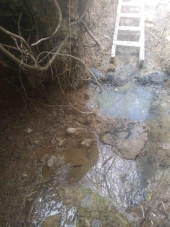
 2
2




 8
8




Idle dreamer
 1
1




'Theoretically this level of creeping Orwellian dynamics should ramp up our awareness, but what happens instead is that each alert becomes less and less effective because we're incredibly stupid.' - Jerry Holkins
 3
3




 2
2




Dillon Nichols wrote:Seems like a perfect spot for an in-law suite to me..
I can picture soaking that water into large scale hugels once you convince it to hold still.
I'm not sure that the usual mantra if 'slow and spread' is practical.. that sounds like a lot of force.
I wonder if one could cut channels back uphill, deep enough to slope down, leading to holding ponds; the water would hopefully mostly rush past rather than all flowing into and then back out of said ponds...
Got any equipment on hand?
 6
6




This is all just my opinion based on a flawed memory

 1
1








Wayne Mackenzie wrote:I have one that runs across the back of my land.
It has become blocked with debris which floods my neighbors to the east.
Honestly, I’m afraid to mess with it.




Wayne Mackenzie wrote:I have one that runs across the back of my land.
It has become blocked with debris which floods my neighbors to the east.
Honestly, I’m afraid to mess with it.
Another thing to remember is there might be restrictions on using the water or even messing around with the area around it.
Drainage easements are very common.




Mark Kissinger wrote:
Wayne Mackenzie wrote:I have one that runs across the back of my land.
It has become blocked with debris which floods my neighbors to the east.
Honestly, I’m afraid to mess with it.
Another thing to remember is there might be restrictions on using the water or even messing around with the area around it.
Drainage easements are very common.
What happened to the picture?
With as much water that was in the picture, you will want to get in touch with the state or county civil engineer to see what they say about the restrictions. The Water Management Group in Tucson is another place to go for more specific advice.
 2
2




'Every time I learn something new, it pushes some old stuff out of my brain.'
 1
1




 1
1




Wayne Mackenzie wrote:Lucky for me I’m at the highest point and have a berm across the back.
My soil is fast draining and deep unlike most of the land around here. I believe it’s from past flooding over decades if not longer.
It’s 18 acres.











 2
2




Moderator, Treatment Free Beekeepers group on Facebook.
https://www.facebook.com/groups/treatmentfreebeekeepers/





 1
1




Phil Stevens wrote:Wayne, is that Ash Creek in the photo? No wonder you've got such good soil. My cousins' family used to live next to the elementary school and I spent big chunks of my summers there when I was a teenager. The north edge of their property grew trees about twice as well as the front part along the highway, all because the soil got better as you got closer to the creekbed.
 1
1








 1
1




Idle dreamer
 1
1




Wayne Mackenzie wrote:The vegetation varies from year to year.
Always get the grass though.
 1
1






|
He does not suffer fools gladly. But this tiny ad does:
The new purple deck of permaculture playing cards
https://www.kickstarter.com/projects/paulwheaton/garden-cards
|






